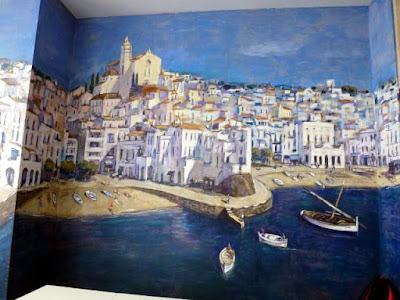The chateau dates
back to 1536 and has since been amended both inside and out many times by the successive
owners. The formal gardens were destroyed to create parkland in the 19th
century. When the castle was bought by Spanish scientist Joachim Carvallo in
1906 he made it his life’s work to recreate the original formal gardens from
ancient plans and documents.
It is these gardens that win universal acclaim, the scale of which can be best appreciated from the upper floors of the chateau. A view of the vegetable garden is below: everything in the photo is the vegetable garden.
The detail is
staggering: each of the squares is planted with a different vegetable. A
close-up shows how precise the layout is. The beds are edged with box hedging
and each area contains a different vegetable. For example, the lollo rosso
lettuce give the red colour, and cabbage for the bright green.
Even at ground
level the intricate geometric shapes are amazing. The plants look so healthy
it’s also amazing that the visitors aren’t helping themselves. And where are
the caterpillars?
Looking down from
the castle again, this is the Love Garden. It’s made of perfectly trimmed heart
shaped box hedging with infill planting.
The water garden is
much plainer but just as precise. The water, i.e. the lake, is on the right in
the photo, although it looks like grass because of the green reflection.
Plenty of exact topiary too. These clipped trees could be chess pawns.
It’s easy to
overlook individual plants with everything on such a grand scale. This group of
irises looked so attractive in the Sun Garden, which was something more of a
mixed variety of plants, shrubs and trees.
The gardens as a
whole are completely replanted twice a year, using 115,000 plants. Half are
grown in their own greenhouses. It’s a staggering enterprise.
The chateau itself,
while beautifully proportioned, isn’t as large or impressive as some in the
Loire Valley. Still, more cleaning and maintenance than we’d be comfortable
with. The moat looks a little soupy in colour- but didn’t smell.
The swans and
cygnets didn’t seem to mind the soup anyway.
Inside, the castle feels
like an Edwardian gentry house, which was Señor Carvallo’s era. There were some
themed designs like the Louis XV dining room. Do I spy butler Jeeves entering by
the far door? Disappointingly, it’s only one of the house guides.
One of the bedrooms
is preserved as Prince Jerome’s, who owned the castle some years before Señor
Carvallo. Prince Jerome was Napoleon’s brother who clearly favoured pink or
maybe Mrs J. did.
The Carvallos
collected many Spanish antiques that are displayed around the castle; even a
Moroccan ceiling originally from a 15th century palace in Toledo,
Spain. So if you ever visit Toledo, look out for a palace with a ceilingless
room.
They amassed enough
paintings for an art gallery, that is housed in the castle, and oddities like
this model of the castle, made out of 100.000 matches. The builder must have
smoked a lot of cigarettes.
But it’s the unique gardens that we’ll remember most. Villandry was only
two miles from our campsite so and easy but very much worthwhile visit
















































